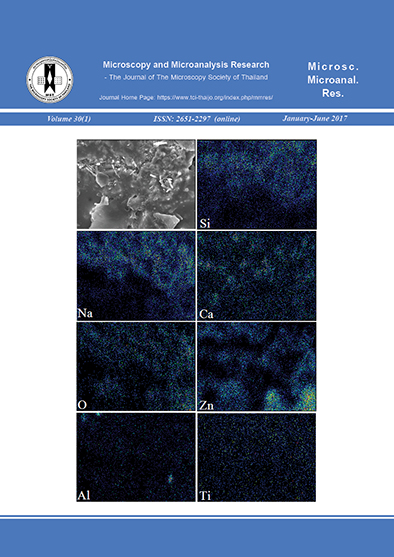Surface Morphology of Echinostoma revolutum (Digenea: Echinostomatidae): Excysted Metacercariae
Main Article Content
Abstract
The surface ultrastructure of Echinostoma revolutum (Digenea: Echinostomatidae), obtained from freshwater snails, Filopaludina spp., naturally infected with the metacercariae, was studied by scanning electron microscopy. The excysted metacercaria was elongated, ventrally concave and pointed posteriorly. The anterior half body surface was covered with numerous peg-like tegumental spines. The oral sucker was circular and was situated subterminally at the antero ventral side of the body. The lip of the oral sucker was devoid of spines. The lip of oral sucker exhibited wrinkled cytoplasmic processes and had ciliated knob-like structure papillae. The head crown was surrounded by 37 retractable, horseshoe-shaped collar spines, which were embedded in cytoplasmic pockets. The ventral sucker was medial at one third of the body. The excretory pore was terminal, and showed a smooth tegument. A number of the ultrastructural features revealed may prove to represent taxonomically informative characters, some of which may be useful at the genus and species level.
Article Details
References
2. M.A. Haseb, L.K. Eveland, Human echinostomiasis: Mechanisms of pathogenesis and host resistance. in: B. Fried, T.K. Gracyzk, (Eds), Echinostomes as Experimental Models for Biological Research, Kluwer Academic Publishers, Dordrecht, 2000.
3. A. Kostadinova, D.I. Gibson, The systematic of the echinostomes. in: B. Fried, T.K. Gracyzk, (Eds.), Echinostomes as Experimental Models for Biological Research, Kluwer Academic Publishers, Dordrecht, Netherlands, 2000, pp. 31-57.
4. S. Yamaguti, Systema Helminthum Vol I. Part I. The digenetic trematodes of vertebrate, Interscience, New York, 1958.
5. I. Kanev, Life-cycle, delimitation andredescription of Echinostoma revolutum (Frölich, 1802) (Trematoda: Echinostomatidae), Sys. Parasitol., 1994, 28, 125-144.
6. L.R. Smales, H.D. Blankespoor, Echinostoma revolutum (Froelich, 1802) Loos, 1899 and (Schrank, 1788) Luhe, 1909 (Echinostomatidae, Digenea): scanning electron microscopy of the tegumental surfaces. J. Helminthol., 1984, 58, 187-195.
7. B. Fried, T. Fujino, Scanning electron microscopy of Echinostoma revolutum (Trematoda) during development in the chick embryo and the domestic chick. Int. J. Parasitol., 1984, 14, 75-85.
8. J.Y. Chai, W.M. Sohn, B.K. Na, N.V. De, Echinostoma revolutum: Metacercariae in Filopaludina Snails from Nam Dinh Province, Vietnam, and Adults from Experimental Hamsters. Korean J. Parasitol., 2011, 49, 449-455.
9. D.M. Kruse, D.W. Hosier, B. Fried, The expulsion of Echinostoma trivolvis (Trematoda) from ICR mice: scanning electron microscopy of the worms. Parasitol. Res., 1992, 78, 74-77.
10. R.L. Ursone, B. Fried, Light and scanning electron microscopy of Echinostoma caproni (Trematoda) during maturation in ICR mice. Parasitol. Res., 1995, 81, 45-51.
11. T. Fujino, B. Fried, D.W. Hosier, The expulsion of Echinostoma trivolvis (Trematoda) from ICR mice: extension/retraction mechanisms and ultrastructure of the collar spines. Parasitol. Res., 1995, 80, 581-587.
12. S.H. Lee, S.J Hong, J.Y. Chai, S.T. Hong, B.S. Seo, Tegumental ultrastructure of Echinostoma hortense observed by scanning electron microscopy. Korean J. Parasitol., 1986, 24, 63-70.
13. S.H. Lee, S.H. Jun, W.M. Sohn, J.Y. Chai, Tegumental ultrastructure of juvenile and adult Echinostoma cinetorchis. Korean J. Parasitol., 1992, 30, 65-74.
14. M. Torii, T. Tsuboi, K. Hirai, H. Nishida, Ultrastructure of sensory receptors of adult Echinostoma hortense (Trematoda: Echinostomatidae). Japan J. Parasitol., 1989, 38, 353-360.
15. S.H. Lee, S.J. Hong, J.Y. Chai, B.S. Seo, Studies on intestinal trematodes in Korea. XV. Tegumental ultrastructures of Fibricola seoulensis according to development stages. Seoul J. Med., 1985, 26, 52-63.
16. S.J. Hong, J.Y. Chai, S.H. Lee, Surface ultrastructure of the development stage of Heterophyopsis continua (Trematoda: Heterophyidae). J. Parasitol., 1991, 77, 613-620.
17. J.Y. Chai, Y.J. Kang, S.Y. Choi, S.M. Guk, J.R Yu, S.H. Lee, Surface ultrastructure of Metagonimus miyatai metacercariae and adults. Korean J. Parasitol., 1998, 22, 70-75.
18. J.Y. Chai, S.M. Guk, E.T. Han, Surface ultrastructure of Metagonimus takahashii metacercariae and adults. Korean J. Parasitol., 2000, 38, 9-15.


